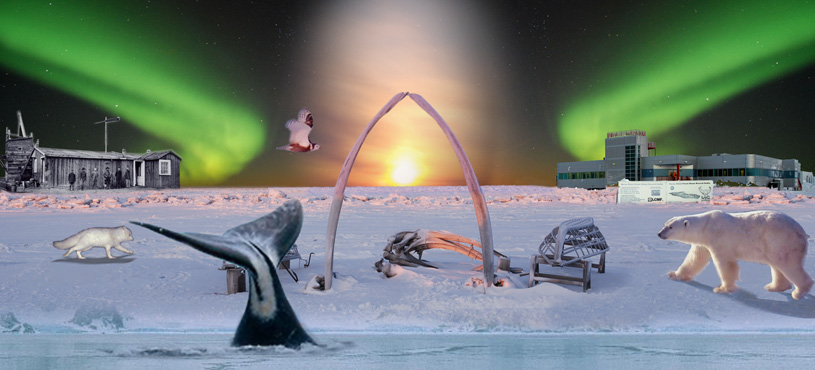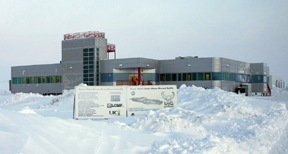
Introduction to the Polar Gateways Arctic Circle Sunrise Conference

Barrow Arctic Research Center, the conference site
The ongoing activities of the International Polar and Heliophysical
Years have offered temporal gateways to our understanding of the icy
polar regions of Earth, effects of solar activity and resultant
magnetospheric interactions on space and atmospheric weather gloriously
manifested by auroral displays in these regions, and how off-world
journeys of exploration enable us to arrive where we started in
comparing the evolution and present environments of comparable other
worlds to those of our home world. How have we arrived at this juncture
from the experience of earlier international epochs, beginning with
Barrow’s historic support of the first IPY expedition of the United
States in the 1880’s and culminating at the dawn of the space age with
the International Geophysical Year (IGY) 1957-1958? What do we really
understand from Earth, heliophysics, and planetary science perspectives
about the dramatic changes occurring in the Earth-Sun-Heliosphere system
as driven by the changing polar and connected heliophysical space
environments? And, quo vadis, how are we to proceed towards what we
might later call the International Planetary Year 2057-2059 in
exploration and eventual human habitation of other polar and icy worlds
in the solar system?
Barrow, Alaska’s “top of the world” municipal and cultural gateway to
the Arctic Ocean, offered a unique venue for the Polar Gateways
conference on scientific and educational exploration of these questions.
The new Barrow Arctic Research Center (photo above), operated by the
Barrow Arctic Science Consortium (BASC) in close partnership with Barrow
and the North Slope Borough regional community, provided a comfortable
modern conference facility connected to remote participants through
videoconferencing. This venue also allowed direct access for on-site
participants to the rigors and wonders of the shore tundra and sea ice
environments just awakening from the darkness of polar winter in this
first week of polar sunrise. The location of Barrow directly beneath the
quiet-time auroral oval provided an otherwise unexpected vantage point
for dramatic auroral displays as we discussed heliophysical connections
of the Sun to the magnetospheric and atmospheric environments of Earth
and other worlds of the solar system. Finally, our close scientific,
educational, and cultural interactions with the local community, sixty
percent native Inupiat Eskimo, provided another gateway of understanding
to how such communities survive, adapt, and prosper in the kind of
extreme and changing environments that will be found on other icy worlds
of human exploration and eventual permanent habitation.
Concepts and leadership for this conference originated within the
ICESTAR/IHY (Interhemispheric Conjugacy Effects in Solar Terrestrial and
Aeronomy Research) international science team of IPY. The conference
chair was Dr. John F. Cooper of the Heliospheric Physics Laboratory at
NASA Goddard Space Flight Center. ICESTAR/IHY team colleagues at the
Swedish Institute of Space Physics at Kiruna, the EISCAT Svalbard Radar
Facility at Spitzbergen, Norway, and the Polar Geophysical Institute at
Apatity, Russia made possible this unique Arctic circumpolar virtual
conference in conjunction with remote conferencing support facilities
provided by the University of Alaska at Fairbanks. We gratefully
acknowledge the invaluable contributions of other technical support
staff at NASA Goddard Space Flight Center, the Jet Propulsion
Laboratory, the University of California at Berkeley, and the University
of Arizona. Principal funding for conference logistics at BASC came
through NASA Goddard from NASA’s Planetary Atmospheres program and was
supplemented by travel support from the ICESTAR team of the Scientific
Committee for Antarctic Research (SCAR) and by community educational
outreach support through BASC from the National Science Foundation. BASC
logistical support was organized by Dr. Glenn W. Sheehan, Executive
Director, and ably provided by other staff of BASC.
“MEN WANTED: FOR HAZARDOUS JOURNEY. SMALL WAGES, BITTER COLD, LONG
MONTHS OF COMPLETE DARKNESS, CONSTANT DANGER, SAFE RETURN DOUBTFUL.
HONOUR AND RECOGNITION IN CASE OF SUCCESS.
SIR ERNEST SHACKLETON”
Finally, we especially thank all, men and women, of our scientific,
educational, and local community participants who responded to a modern
version of Sir Ernest Shackleton’s famous advertisement above for his
epic 1914-1917 Antarctic expedition to explore the icy polar world of
Barrow with us during the frigid week of polar sunrise. Our older
participants provided the elder knowledge of past to present also much
prized in the cultural heritage of the local Inupiat community. Our
legacy to the future is the knowledge shared with the younger
participants who in turn told of their own ongoing investigations and
will carry on in future exploration of Earth and the solar system. As we
heard directly from several participants of fifty years ago in IGY, so
will some participants hopefully pass on our current exploratory
knowledge of polar and icy worlds to the generations of that future
world, on Earth and beyond.


